![]()
![]()
![]()
Use LEFT and RIGHT arrow keys to navigate between flashcards;
Use UP and DOWN arrow keys to flip the card;
H to show hint;
A reads text to speech;
7 Cards in this Set
- Front
- Back
- 3rd side (hint)
|
Types of joints 1. About joints 2. Ball and Socket 3. Hinge |
1. The skeleton is framework joined together by joints. Joints are necessary for muscles to lever bones, creating movement. A joint is formed where any two or more bones meet. Joints are classified by how much movement they allow - fibrous or fixed joints, catilaginous or slightly moveable joints and synovial joints including the hip, shoulder, elbow, knee and ankle, the ball and socket joint and the hinge joint. 2. Allows movement in every direction. It is formed by the round head of one bone fitting into the cup-shaoed capsule of the connecting bone. The hip and the shoulder are ball and socket joints. The articulating bones of the hip are the femur and pelvis and the humerus and scapula articulate at the shoulder. 3. Allows movement in only one direction during to the shape of the bones making up the joint. The ankle, knee and hip are hinge joints. The articulating bones of the ankle are the talus, tibia and fibula. The femur and tibia articulate at the knee and the humerus, radius and ulnar at the elbow. |
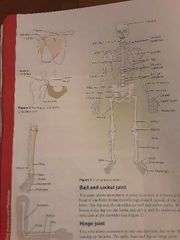
|
|
|
Planes and Axes 1. Planes 2. Axes 3. Joint action |
1. Planes of movement divide the body in 3 ways: Sagittal plane - vertical plane that divides the body into right and back halves. Frontal plane - vertical plane that divides the body into front and back halves. Transverse plane - horizontal plane that divides the body into upper and lower halves. 2. There are 3 axes of movement about which rotation occurs: Transverse plane - runs from side to side across the body. Sagittal - runs from front to back. Longitudinal - runs from top to bottom. 3. A joint action taking place can be related to both planes and axes - Flexion, extension, plantar-flexion, dorsi-flexion and hyper-extension occur in a sagittal plane about a transverse axis. Adduction and abduction occur in a frontal plane about a sagittal axis. Horizontal adduction and abduction occur in a transverse plane about a longitudinal axis. |
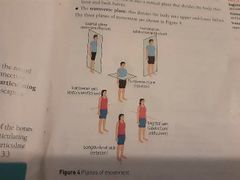
|
|
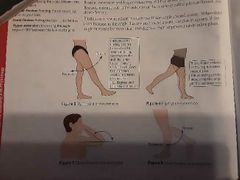
Sagittal Plane and Transverse Axis 1. Joint actions 2. Flexion and extension 3. Hyper-extension 4. Shoulder flexion and extension |
1. Flexion, extension and hyper extension as well as plantar and dorsi flexion at the ankle. 2. Flexion occurs when there is a decrease in the angle around a joint while extension occurs when there is an increase in the angle that occurs around a joint. 3. Hyper-extension is when the angle increases by more than 180⁰. 4. With the arms by the side of the body, if the arms are raised forward then flexion occurs and if they are lowered back down extension occurs. |
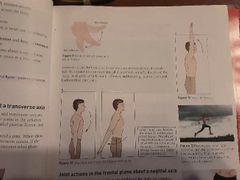
|
|
|
Frontal Plane and Sagittal Axis 1. Abduction 2. Adduction |
1. Abduction is the movement away from the midline of the body. For example - raising your arms and legs out to the side away from your body. Adduction is the movement towards the midline of the body. For example - lowering the arms and legs back to the sides of the body. |
|
|
|
Transverse Plane and Longitudinal Axis 1. Horizontal adduction 2. Horizontal abduction |
1. The movement of the arm forward across the body at 90⁰ to shoulder abduction. For example - raise your arm out to the side until it is parallel to the floor (abduction of the shoulder) and then move it across the body. 2. The movement of the arm backwards across the body to shoulder abduction. For example - raise your arm and hold it ar 90⁰ (flexion of the sboulder) then move it away from the body. |
|
|
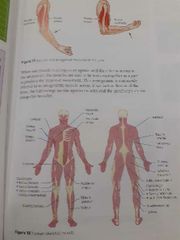
Agonist and Antagonists 1. Information 2. Examples |
1. When a muscle contracts it is anchored in place and the other end pulls the bone causing movement. When one muscle is acting as an agonist the other is acting as an antagonist and the muscles are said to be working as a pair to produce the required movement. This arrangement is commonly referred to as antagonistic muscle action. 2. Biceps - the anchor point is the scapula (shoulder) and the other end of the muscle attaches on the radius (forearm). The bicep is responsible for flexion of the elbow and then the muscle contracts the radius moves upwards towards the shoulder. When the bicep contracts, it is responsible for the movement that is occuring and is said to be acting as an agonist. An antagonist muscle is one that works in opposition to the agonist, so when the bicep contracts, the tricep lengthens and acts as the antagonist. Flexion of the knee - the hamstrings are the agonist muscles and the quadriceps are the antagonist muscles. |

|
|
|
Types of Muscular Contraction 1. Muscle contractions 2. Isotonic 3. Isometric 4. Comparison |
1. A muscle can contract in different ways, depending on the muscle action that is required. An isotonic contraction is when a muscle contracts to create movement. There are 2 types of isotonic contraction - when the muscle shortens as fibres cotract a concentric contraction is taking place and when the muscle lengthens an eccentric contraction is taking place. An isometric contraction occurs when the muscle is contracting but there is no movement occurring. 2. A muscle causes movement in an isotonic contraction and there are 2 types: Concentric - A muscle shortens under tension. E.g. during the upward phase of a arm curl, the bicep performs a concentric contraction as it shortens to produce flexion of the elbow. Eccentric - The muscle lengthens under tension (and does not relax). Whent a muscle contracts eccentrically, it is acting as a brake in helping to control the movement of a body part during negative work. E.g. - landing from a standing jump - the quadriceps are performing negative work as they are supporting the weight of the body during landing. The knee joint is in the flexed position but the quadriceps are unable to relax as the weight of the body ensures that they lengthen under tension. 3. When a muscle contracts without lengthening or shortening and the result is that no movement occurs. This occurs when a muscle is acting as a fixator or acting against a resistance. E.g. the crucifix position in gymnastics. 4. Bicep curl Concentric contraction - during the upward phase, the bicep brachii contracts to produce flexion of the elbow joint. Eccentric contraction - during the downward phase of, if you put your hands on a partners bicep brachii you will still feel tension. This means the muscle is not relaxing - it lengthens under pressure. Isometric contraction- if the weight is held at a 90⁰ angle the bicep brachii is under tension even though we do not see any movement. |
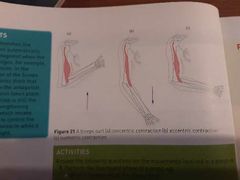
|

